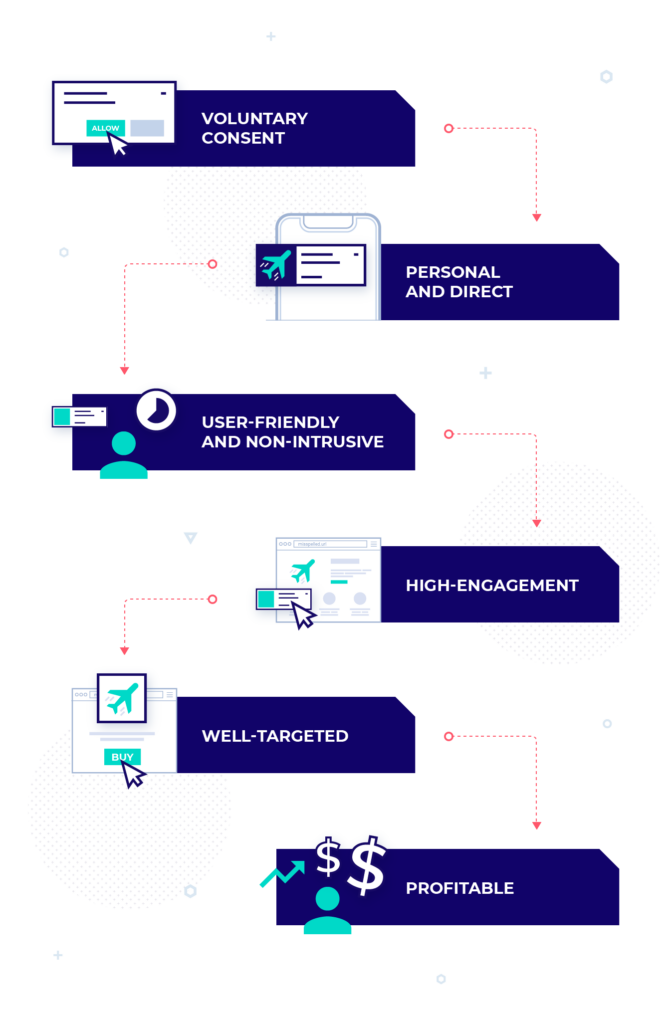Contents
The Ultimate Guide to Push Advertising 2022
•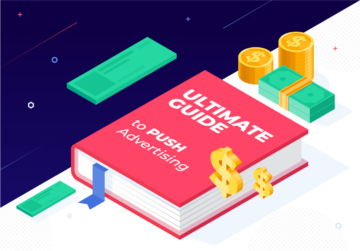
Push Traffic, Push Ads, Push Notification Advertising — whatever the name is, there’s only one thing that truly matters. The Push Notification Ad format has rocked the affiliate marketing world in 2021, and 2022 hasn’t been any different.
If you want to learn all about push traffic, starting from what’s the whole fuss about to the best optimization and targeting practices, this guide is here to give you that. Also, find the industry pro tips on how to protect your investments, tap into consumer demand and scale your push ads campaigns.
Read the Ultimate Guide to Push Advertising and become an ultimate push ads expert!
Introduction to Push Traffic Advertising
The first thing everybody needs to know about this particular ad format is that push advertising is voluntary! Users have to opt in to receive such ads, which means you’ll be targeting only those users who want to be targeted, as a result they’re generally considered user-friendly, thus ultimately having a much bigger chance of reaching a highly engageable audience. Isn’t addressing users who engage with your ads a key to every successful affiliate marketing campaign? Of course, it is. And push advertising does exactly that.
What are push ads? Push Advertising definition
Push ads are a type of native ad format. Push advertising means delivering ads to users’ desktop or mobile devices in a form resembling usual push notifications, thus offering a non-intrusive, user-friendly, and highly engaging way for advertisers to reconnect and expand their audiences.
The bonus from this ad format is that it can be used for nearly any type of advertising campaign due to having a very low chance of bot traffic, high global reach, and higher click-through and conversion rates than other ad formats.
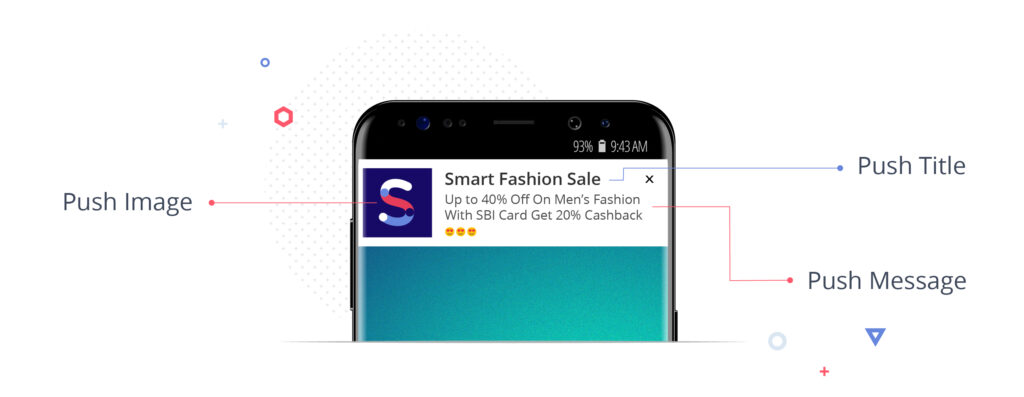
Read a Brief Introduction to Mastering Push Ads in Zeropark Here!
Push Ads — technical meaning
Now, let’s get into more details on what push traffic is using more technical terms:
- Called web push notification ads, they are commercial messages served by websites (rather than apps) on both desktop and mobile devices. Users who click on those messages get redirected to a product offer or a landing page (or a microsite), thus generating a conversion.
- These short interactive messages are built of an ad image and copy related to your offer (resembling SMS alerts or app notification) and are delivered straight to an ad recipient’s mobile or desktop device.
- Users need to opt-in to start receiving push ads from websites. Subscribers get only a limited number of notifications per day and can opt out any time they feel like it.
What’s also worth knowing is that push ads notifications cooperate smoothly with some of the most popular browsers. While surfing the web, you have probably come across a website displaying a small pop-up, asking to send you notifications — that’s precisely how users subscribe to receive push ads.
Speaking of Internet browsers, push ads are usually supported by:
- Chrome, Firefox, Safari, Edge (on both mobile and desktop),
- Windows, macOS, and Linux (on desktop)
- Android (on mobile)
Note that push ads aren’t supported by Apple on their iOS devices.

If you’d like to learn more about in-page push, click here and read all about in-page push and find out why it’s different from standard push ads (it works on iOS devices).
Read Everything About Push Ads on Mobile iOS Here!
Push Notifications vs. Push Ads Notifications
Push notifications, come directly from applications users download on their phones and have been developed as a means of internal communication. They have been invented along with push messages and push notifications technology. They are not a part of the affiliate marketing industry, though are commonly used for marketing purposes, too.
Push ads notifications, on the other hand, are online ads coming from websites they’re meant to drive traffic to and are possible on both desktop and mobile devices. Any publisher is thus allowed to enable push advertising on their websites to the subscribed users. Push ads are one of the ad formats available in the affiliate marketing industry.
Push notifications and push ads notifications are both types of Internet-based communication, yet they shouldn’t be mistaken as the same thing. They both come in the form of small instant messages, they’re quick and non-intrusive BUT push ads notifications serve marketing purposes and were created to resemble push notifications. Push ads notifications, meaning push traffic, wouldn’t exist if it hadn’t been for the development of push notifications.
Push Ads vs. SMS and other Ad Formats
Picking an ad format for your affiliate campaigns should include thorough research, industry insights, and a careful comparison of various inventory the industry has to offer. Whether you’re juxtaposing push vs. domain redirect, or push traffic vs. pop traffic, here are push traffic pros and cons to bear in mind.
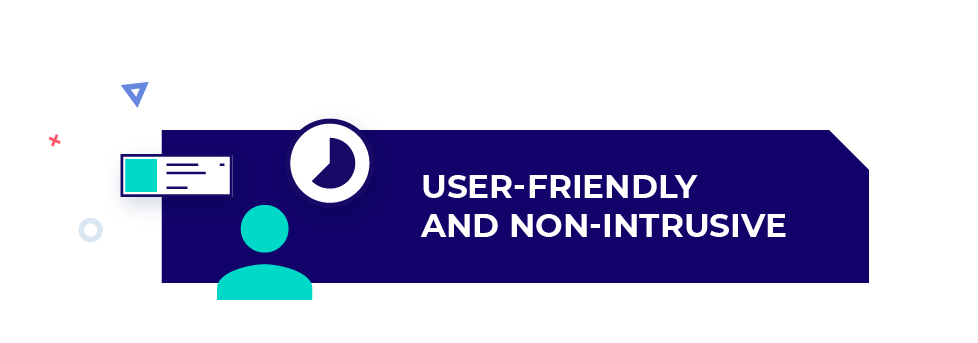
Some of the benefits of push ads compared to other ad formats would be:
- Again, the fact that push ads are voluntary. One needs to subscribe to receive them, which means they come across as more user-friendly, less annoying, and way more agreeable than other ad formats unless an advertiser makes them too pushy.
- Push Ads are delivered straight to a recipient’s mobile or desktop device, which gives them a more personalized and user-dedicated feeling.
- Because this ad format resembles SMS alerts, push ads seem more familiar and natural to users, especially on mobile devices! Thus, increasing your chances for successful user engagement.
- Publishers can also enjoy the possibilities provided by web push notifications, e.g.: an easy way to collect and monetize a visitor database. Users don’t even need to browse a website to receive push ads. What a win-win scenario is that!
- Due to their nature, push ads are considered to be a new native ad format, offering all the perks of native advertising, such as cost-effectiveness, a wide audience pool, and precise user targeting.
- Based on set preferences, the recipient of the ad is served non-intrusive relevant offers even when he or she is not browsing. Meaning, advertisers can surgically target a highly engaged audience and generate an instant response.
- Just as users need to opt-in to receive push ads, they can always opt-out if disinterested, too. This saves you time and money targeting audiences who wouldn’t convert anyhow and leaves people with an option to choose, thus more likely to come back without regrets on one day.
- The Click-through rate is particularly high with push ads. What’s worth remembering is that CTR may be a great tool for user prequalification. If someone clicks through your push ads, they’re much more likely to convert. Simultaneously, advertisers get more data on what’s been working well and what gets users’ attention.
- All this makes push ads inherently user-friendly, ensuring high-quality traffic and engaged audiences for your campaigns.
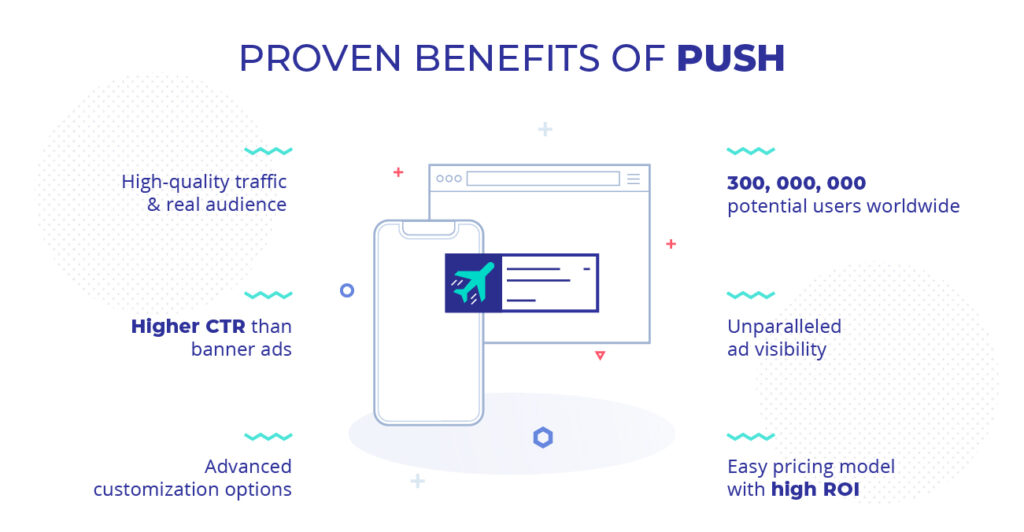
Sign Up to Run Zeropark Push Ads Campaigns Now!
To give you the full overview, here are also some push ads drawbacks:
- Running push campaigns is not a no-holds-barred situation! It means – among others – limited adult campaign possibilities, no auto-downloads, no malware, no adware, and no trademark violations. Keeping your push ads campaigns clean is a must!
- Next, push notification ads (just like any other ad format) may easily become intrusive to users. Advertisers need to pay attention to user experience and the possible reactions of their audience while setting up, and later targeting and optimizing their push ad campaigns.
- No iOS targeting for push ads. Thanks, Apple!
- Direct linking doesn’t work well with push, having a landing page (or running push traffic campaigns with microsites) for your offer is a recommended option.
- You pay for the actual clicks only, but a high CTR doesn’t always lead to a high conversion rate.
- Due to their profitable reputation, competition in push ads is constantly growing, so you need to spend more to win a bid and also fight banner blindness or market saturation.
Nevertheless, the said drawbacks are easy to overcome even for less experienced affiliates. Follow the tips included in this guide, talk to your traffic source representatives or search for industry insights. Using the tips and tricks the affiliate industry happily shares allows you to stay up to date and get way ahead of your competition!
Where Does Push Traffic Actually Come from?
As an affiliate advertiser, you receive your push traffic from a traffic source, which we’ll discuss more closely in a bit. But where do traffic sources get it from? Well, it doesn’t just magically appear in their dashboards… that’s what publishers are for.
The road to push ads impression
Push Traffic Publishers, meaning webmasters or site owners, ad networks, toolbar and plugin owners or domainers — all these clever folks are welcome to join a traffic source platform and provide supply for advertisers’ demand (who in turn are the supply side for users’ demand).
What happens next is that publishers who would like to offer their ‘digital space’ and have ads placed there need to go through a verification process (a quality traffic source ensures they do not let any fraudulent, bot, or simply poor quality traffic in) and then integrate with a chosen platform. Thanks to the integration (usually done via XML, JSON, or OpenRTB) every time a user enters a particular website a request for an ad to appear is sent… oh, wait. That’s not push traffic!
Let’s not forget that push ads are sent to subscribed users’ devices regardless of whether they’re currently browsing the Internet or not. Here’s a quick road to push ads impression:
- Publishers need to enable a subscription option so that users entering their websites receive subscription notifications (usually it’s the “Allow Notifications” popup).
- The displayed notifications ask if users would like to allow push ads notifications. If they agree, then they’re added to the subscription lists.
- Such lists are then aggregated and segmented depending on the age of the subscription. The fresher a subscription, the better.
- Push traffic sources are then made of the subscriber’s lists, and push ads can be sent to particular sources, depending on the advertiser’s targeting choices.
- The users who opted-in receive push ads notifications.
Read A Zeropark Push Ads Success Story by Servando Silva Here!
Why do Push Ads work?
Consumption does not stop… ever. With the world of digital marketing constantly evolving, the affiliate marketing industry also needs to break through all that noise. What’s the best way to do just that, and do it with a bang? Innovate! That’s how we got push ads.
The SODP report shows that a US-based audience of 100k monthly unique viewers, with an average opt-in rate of 4% and subscriber churn of 20% can grow our push ads notifications audience to more than 15k subscribed users in just six months. This is with users receiving up to 2 push ads notifications daily. According to SODP sending an additional two push ads a day could result in more than 18k clicks and revenue of $1,828 in the first month.
What does it tell us or why does it matter? People like receiving ads in the form of push notifications. They subscribe to get them, hence publishers get their share of traffic, and advertisers get their audience. Everyone’s happy, and the business is rolling.
Push ads notifications are a win-win scenario for everybody — publishers, advertisers, and users. To make your affiliate efforts an ultimate success you need to do one more thing… give people exactly what they’re looking for!
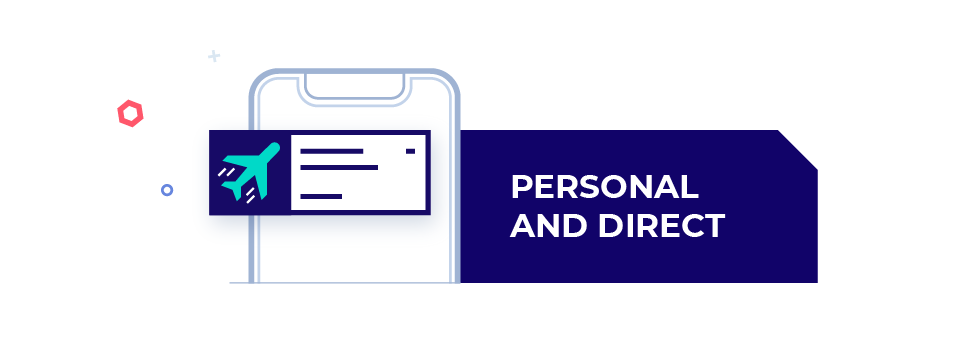
Best offers and verticals for push notification advertising
That’s why finding the perfect match of an offer and a vertical is everything in any affiliate marketing ad campaign. With push ads giving advertisers a tremendous potential for getting directly in touch with highly interested users, there’s plenty to choose from. And remember that push has little in the way of demographic targeting, which means wider campaigns.
The top-performing push traffic verticals include:
- E-commerce & Travel
- Mobile Apps & Games
- Gambling & Sports Betting
- Sweepstakes/Coupons
- Dating
- Health & Beauty
- Finance
- News & Entertainment
- Video Streaming
- Job Search
The above should not come as a surprise, especially the top one. E-Commerce and Travel & Hospitality are the all-time stars especially for the Golden Quarter period — meaning Q4 with all the Black Weekend events and the Holiday Season. So, you won’t go wrong with any of the verticals on the list, as they are the most profitable in 2022.
Verticals are especially helpful when trying to step into your ad recipient’s shoes for a bit. What do you think happens once all the Holiday Season shopping craze is gone and dusted? NEW YEAR RESOLUTIONS! What vertical does it mean? Naturally, the Health & Beauty sector. And every year the phrase “new year, new me” is heard, which is another big opportunity. Always think through the proxy of users’ eyes to stay one step ahead. Once you’ve made up your mind as to what industry sector you’d like to go for, the next step would be to find the exact offers.
Read How to Scale With Push Ads During Holiday Season and Fight Creative Fatigue Here!
Examples of successful push ads offers would be:
- E-commerce offers:
So we’ve already established that the e-commerce vertical rules them all in Q4 but it doesn’t mean it’s not performing well throughout the rest of the year. It can be considered as one of the most credible and sustainable verticals to promote. Consumption does not stop… remember? Plus, there’s always someone looking for discounted items and someone discounting them — you’ve got to find yourself in the middle. Do that either by promoting specific products or going straight to one of the big guys and promote them:
Amazon, Flipkart, Gearbest — these agencies are always happy to welcome an affiliate advertiser just like you. According to CNBC (Consumer News and Business Channel), Amazon took over almost 50% of the US e-commerce market. We guess it’s also safe to say that there wouldn’t be e-commerce without Amazon. We also guess it’s safe to assume they’d use a hand or two promoting goods.
Alternatively, promote specific products. Once you find a suitable offer, try to follow the usual user engagement tricks. Make your ad noticeable, but not too much. Intrusive and flashy ads have the exact opposite outcome. A good idea could be creating a funnel that makes it easier for a customer to engage and in the end complete it with a product purchase.

- Mobile Apps & Games offers
People use apps for everything, they need an app to remind them of breathing. Or even better, imagine you’re promoting a battery-optimizing app. Such offers tap straight into consumers’ demand and that’s precisely why utility apps are a thing, especially if targeted on mobile devices.
Add a simple illustration, e.g.: a fully-charged battery, a straight-to-the-point title ( use emoji!), and a clearly stated benefit of downloading the app (e.g.: 90 extra minutes on your battery), plus an obligatory CTA. Simple yet genius! As for game downloads, there’s plenty to choose from. Include a proper title, encouraging CTA, or even challenge them a little! If they’re looking for a bit of excitement and a competitive spirit, that’s what you should give them.
- Gambling & Sports Betting offers
The sporting calendar is full all year round, so there’s always something to promote. Plan your advertising calendar accordingly and you’ll be just fine — usually, a day or two before an event is the best time to start targeting it. Don’t forget to adjust your copy and creatives! The casino offers work similarly — if people seek gambling thrills, create a sense of urgency to stir things up a little. But remember, there are always regulations and restrictions surrounding these offers so do your research before you run your campaign or risk wasting your money.

- Sweepstakes/Coupon offers
Sweepstakes/Coupon or Win-an-item offers are generally popular verticals among various ad formats. Win an iPhone, get a Walmart or Amazon gift card — these are just the most popular examples. Such offers are especially successful with push ad notifications thanks to their direct engagement and non-intrusive, yet promising character. The conversion flow usually involves a prelander where users are desired to leave their details. Sometimes an email address is enough, and sometimes these are credit card details, which come with a higher payout. Highly engaging creatives and landers can be the key to your sweepstakes push ads campaign!
- Dating offers
The dating vertical is one of the crowning jewels of the most successful affiliate ad campaigns. No wonder then it’s doing fantastically on push traffic, too! What’s quite surprising is that it’s doing so well on push despite its restrictions regarding keeping things clean. Remember — it’s mainstream so no explicit adult content is allowed! And yes, it’s still possible to get numerous offers and make some nice figures when run on push.

- Health & Beauty offers
Remember that health, wealth, and romance are never dead? Promoting offers in the scope of this vertical will be successful as long as people want to stay young, beautiful, and successful… meaning forever. Just as with the sporting calendar, the beauty and health season can keep you occupied a whole year-round. New year resolutions, getting that bikini body, protecting your skin during summertime, staying healthy once autumn kicks in, or, again, preparing your skin, hair, everything for the winter season. Not to mention the billion-dollar beauty industry setting different trends every quarter. It’s worth it.
Sign Up to Run Zeropark Push Ads Campaigns Now!
Be picky with your Push Ads Traffic Source!
Yes, you’re perfectly right to be picky when choosing a traffic source for your push traffic ad campaigns. You may have the best ideas, offers, verticals, creatives, copy, and a much-needed aptitude or affiliate marketing acumen… but you can burn it all real quick if your traffic source doesn’t rise to the challenge.
If you’re to partner up with someone, do it wisely. Choose a credible traffic network with a proven track record of successful push ad campaigns and a guarantee of high-quality traffic. There are several questions you can ask to find yourself a perfect match. Some of them are listed below, read on and make the best decision for your push ad campaigns.
#1 Does a traffic source offer push traffic ad format?
As simple as it sounds, not all of them support the type of advertising you’re looking forward to monetizing. Then again… if a traffic source does not support push traffic yet, is it keeping up with the latest industry trends? With the digital marketing business rapidly growing and affiliate marketing keeping up with the fast-paced market changes, staying up to date is the bare minimum. A traffic source that gets ahead of the curve and provides its customers with innovative solutions is already making the affiliate future look much brighter.
#2 Do verticals, angles, and niches supported by your potential traffic source match your push traffic ad campaign choices?
It may seem like no issue at all but various traffic networks may enable or not specific types of campaigns, e.g. adult. Make sure that if you want to go for a mainstream-only or adult-only type of push campaign it is possible to distinguish.
#3 Are the targeting options available suitable for push traffic campaigns?
Targeting is key. Even the finest campaign setup can go wrong if the people it addresses are in for something entirely different. Or worse, they get confused, annoyed and the next thing that happens is that your campaign is ultimately ignored.
Since the moment it launched, push traffic has been the ad format… and your competition never sleeps. The average bid prices’ inflation is one of the consequences of market saturation. It happens due to affiliates constantly increasing offered bids to win bigger shares of push traffic. Another problem, also tied to the density of advertisers on the push market is banner blindness or ad fatigue, and consequently ad burnout. These issues can be fought through precise targeting choices, then testing and optimizing. And if a traffic source does not provide you with enough tools to arm yourself against the market saturation threats, then it’s already a sign they won’t be able to have your back. Think ahead!
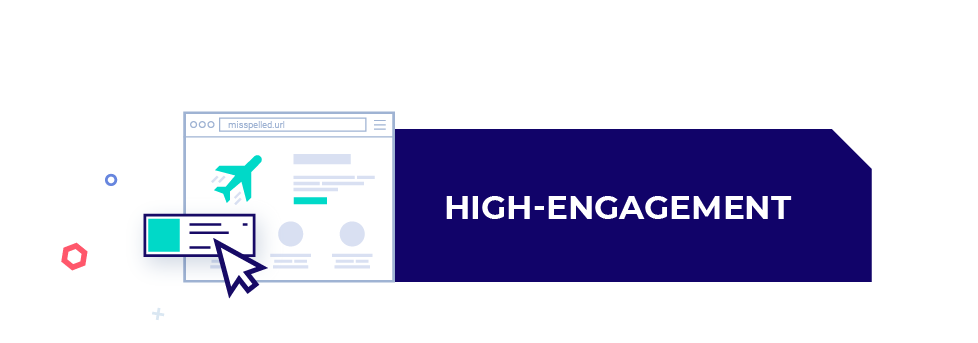
#4 How much push ads traffic can a traffic network offer you?
Know the available volumes before signing up with a given traffic source. A quality traffic network should be able to share that information and thus help you estimate the scale of your campaigns or possible optimization strategies. For example, Zeropark allows doing that via its Traffic Calculator feature. Such tools give you the average bid prices and monthly traffic volumes available for all its ad formats and location-based push advertising.
Regarding push traffic competition, knowing the volumes of available traffic is crucial. Once the hot season kicks in, everybody wants to get their share, and breaking through a crowd may need special measures. Make sure your affiliate efforts are worth it before entering the game.
#5 How much does a push traffic campaign cost with a traffic source of your choice?
Estimate your spending budget, but do remember to include the testing phase! Also, think about how long you’d be able to run it and how much you’d be able to spend on it. Testing, optimization, and then scaling up your campaigns all needs funding. This is again when Traffic Calculator may come in handy. It allows you to check the average bid prices for given GEOs and then perform all the needed calculations.
Apart from available volumes, average bid prices, testing phase budget, and its duration, there are also a few other things to keep in mind. A credible traffic source lets you know all that before signing up so as you’re fully aware of what you’re getting into.

Try to find out the initial items listed below:
- How much is the entry deposit?
- How do I top up my account?
- What are the payment methods?
- Are there any long-term deals or discounts?
Then, look out for more information regarding:
- The volume of push traffic offered by a traffic source.
- Push traffic quality.
- The cost model of push ads.
- The estimated cost-per-bid.
- Push traffic smart bidding or budget capping options (also including AI-powered solutions)
Putting all these elements together allows us to estimate how much a push ads campaign can cost us. Remember, your push traffic ad campaign ROI depends on many things.
#6 What are the traffic source rules and regulations?
Compliance rules may be especially important in the case of push ad notification advertising — push needs to stay clean. To know what’s allowed and what’s not, read the traffic source’s compliance rules carefully. A traffic source that takes such regulations seriously is already a sign of high-quality service. Also, if you’re planning on running highly adult-oriented campaigns, it might be worth reconsidering your choices.
That’s what a verification process is for, though. Learn what’s the account and campaign verification process, who approves it and how they do it. Knowing how long it takes to get your campaign fully approved before you make up your mind is also recommended. Affiliate marketing is a dynamic industry, so timing might be crucial for your campaign’s success.
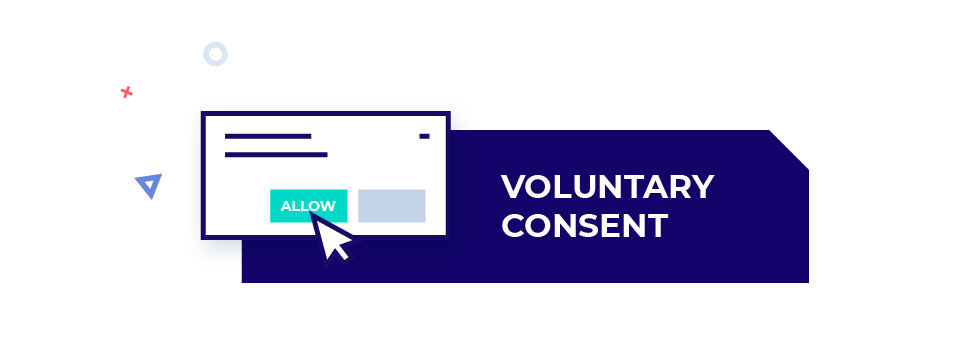
#7 Is it a credible traffic source for push ads campaigns?
If you want to earn money, invest first. This means not only investing in your advertising budget but also coupling up with a credible traffic source — and quality always comes for a price. Yet, there are a few ways to make sure you’re choosing the right service.
Start by making yourself familiar with official information. Full disclosure and transparency prove a traffic source to be credible and far from any shady schemes. Next, talk to the traffic source representatives. Remember, it’s now about how cool these guys are but how helpful they are in making your push ad campaigns as profitable as possible. Then, search the community forums. The affiliate marketing industry is unbelievably helpful when it comes to sharing valuable information amongst affiliate community members. This also means that if there’s anything wrong with a traffic source of your choice, people probably already know it. Aks, learn and research — then make up your mind who to partner up with to run successful push ads campaigns.
#8 Does a traffic ad network offer a user-friendly platform?
Being comfortable with the tool that may be a make or break element for your affiliate efforts is a must. A good quality traffic source should provide you with a tool that’s easy to operate, intuitive, and user-friendly. A demo version enabling you to get a preview of what the platform looks like would be great to have but not everybody offers it. Another thing would be the onboarding process and further support — if a traffic source takes care of its users both at the very beginning of the cooperation and at a later stage, too, then it’s something worth considering.
#9 Does a traffic source offer campaign testing options or AI-powered solutions?
We’re talking about ad-tech business here, so obviously we’d also expect the proper level of technological advancement. With the digital marketing business constantly coming up with new technological solutions to aid the marketing struggle or boost digital performance, traffic sources should be no different.
That’s why things like AI-powered solutions or automated integration options are a must. The amount of data or the processes happening in split seconds require technologically advanced support. A high-quality traffic source does not only provide you with such but also keeps on improving the existing option and also developing new ones.
#10 Is it possible to integrate a traffic source with other platforms?
No campaign can be successful without a tracing solution. We’ve discussed how important having a tracker is and what they bring to running your push ads campaigns numerous times. But being able to combine the two tools is everything.
Make sure that once you’ve got your traffic source selected as well as your tracker the two can be integrated. Data is everything and having a clear view of it is crucial for concluding your testing phase and then optimizing your push traffic ads.
Read How To Compare Push Ad Networks Here!

Push Ads Traffic Networks Overview
There are several traffic sources offering push ads traffic and let’s face it — everybody claims they’re the best on the market. But who checks all the ten boxes listed above? Finding one that does that may seem like a challenge but it’s an essential step to be made. And as always, the affiliate community is full of helpful tips, reviews, and people sharing their experiences.
Starting with the basics, the main difference would be of course ad formats available. When it comes to push traffic, traffic sources like Mobidea Push or MegaPush are push traffic-only networks. Propeller Ads, AdMaven or Zeropark offer other ad formats, too. In case you’d like to stick to one tried and tested solution for your other ad campaigns, not just push exclusively, then going for the second group would be a much better idea. When it comes to managing multiple sites for your push ads campaigns, it’s important to partner with traffic networks that offer comprehensive targeting options and can help you optimize and scale your campaigns across multiple sites. This is a crucial step to ensure that your campaigns are reaching the right audiences. So, you may want to consider the available targeting options and the network’s ability to help you manage and scale your campaigns when choosing a push ads traffic network.
As for angles, verticals, and targeting options available, the case is much more detailed. There’s always an absolute minimum of what a network should offer, like GEO or device targeting, mainstream or adult traffic, or bid adjustments.
Traffic sources like Mobidea Push, MegaPush, PropellerAds, AdMaven, or Zeropark are already considered credible choices by the affiliate community and have proven high-quality service. They all offer quite similar basic feature sets. If a traffic source you’re considering doesn’t support things these guys do… well, you’ve got your answer. So which one to choose? It depends solely on what your needs and goals are.
Propeller Ads, for example, offer an option rather rarely available with other networks — segmentation by user activity. Their bid optimization has to be done manually, though, unlike the automated bid optimization in Zeropark. Propeller Ads allows both icon and banner images for their push creatives, whereas Zeropark offers icon only, but then again Zeropark allows a longer message text. Which one’s more important for you?
In terms of choosing a budget-friendly traffic network, mind the overspend. Delay in seeing the actual results and thus risking spending more than your budget allows is one of the most frequently mentioned issues across affiliate forums. Sadly, it’s one of the push traffic characteristics and cannot be easily avoided. But, it doesn’t mean people aren’t trying to change the situation. Look for a traffic source that protects your interest and has the technology to prevent budget overspend — like Zeropark.
Another quite crucial difference is that Zeropark allows moderate adult content for your push ads creatives whereas other traffic sources do not allow even that much. Also, Zeropark’s CTR optimization feature enables highly-clicked creatives to be displayed more frequently than the worse performing designs — this means bigger exposure for better-converting units.
What’s worth mentioning in terms of AdMavenm and MagaPush is that the first one allows dynamic callouts, which might be a great tool as long as the automated setup works well, while the second allows only one creative per campaign only — so you need to be sure of it. The list of pros and cons of each network might be very long or super short depending on what you’re looking for. Ask, research, and follow the tips included in this article to make the best choice when picking your push ads traffic source.
Click Here And Read A Case Study On Push Campaign Optimization!
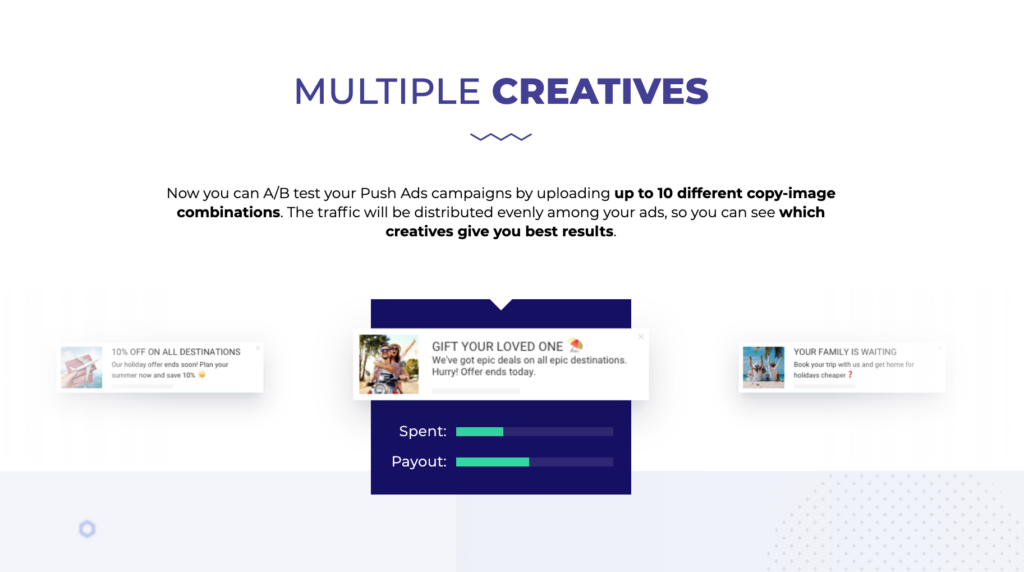
How to build Push Ads — the best push ads format
With push notification ads occupying the top place of the most popular ad formats in affiliate marketing, fighting market saturation and creative fatigue is a must right now. Whether displayed on mobile or desktop it needs to attract attention, keep high-quality standards, encourage engagement and remain simple. It sounds like quite a task, especially that there are just three elements for you to combine — an image, a title, and a short copy.
Creatives you need to succeed and earn money
Let’s start with an image. Here are a few rules to keep in mind.
- Choose a simple yet eye-catching image. If you’ve ever seen a push ad notification then you know there’s little room for getting crazy. Also, don’t get crazy. With push ads simplicity is key, but it doesn’t mean staying boring. Funny push ads might be the key to success! Also, mind the ad fatigue creeping. Have several patterns to test, adjust them, make changes and keep them as your backup to refresh your push ads campaigns once the dreaded moment comes.
- Icons convert better than images. That’s quite reasonable given that complex graphics have simply too many elements to focus on, thus distract users from the main message.
- Color matters! Whenever an image or words can’t say it all… colors can. Certain colors send instant and clear messages to our brains and thus seem like a perfect solution for your push ads. Green is generally considered to be the best-converting color, while red is read as an alert. Black and white always seem to be a safe option. Remember to adjust your color choices for special occasions, though. Go black for Black Friday, combine red and green for the Holiday Season, throw in some gold and silver for the new year and keep the pastels coming for the springtime!
- Keep it simple! The push ads creatives are tiny, hence baroque-style paintings are not the best choice. Keep your images simple and direct for your audience to instantly get the message. Remember to keep the images clear of text, there’s space for that somewhere else. That’s why icons are a great tool, in this case, they can say more than a thousand words.
- People love emojis! That’s not a newsflash, yet it’s worth reminding that emojis are said to increase CTR by approximately 25-40%. Again, creating funny push ads can be much easier when one’s got emojis at hand. Don’t overuse them, though. Having an emoji as the main element of your image is a great idea, but keep your copy clear.
Plus, don’t forget about spying tools! These allow you to get a cheeky look into what’s your competition up to but don’t just copycat things! This will only increase ad fatigue or market saturation and, what’s worse for you, will not convert. Treat it as a research tool, draw conclusions, improve and outdo the competition.
Read About Hottest Creative Trends Here!
Copy that converts and earns you money
Once you’ve got your perfectly colored and structured image, it’s time to write copy that converts. Push ads notifications still have two more elements — a title and a message.
- Push ads title. The push ad title can be considered equally important to the push ad’s image. But there are a few restrictions when compared to other ad formats — it needs to be short, engaging and it needs to convert.
Usually, you’re able to distinguish a title from the message part, for example by using bold font. Since there’s not much space (usually around 30 characters per title) there’s no room for beating around the bush. And once a user sees it, he/she reads it in a blink of an eye and that’s enough to engage or disengage.
That’s why emojis can work so well if used in titles. They convey a lot of meaning in just one symbol and they’re attention-grabbing, which is exactly what you need. Treat titles as CTAs rather than information, they can truly be the make or break apart.
- Push ads message/description/body/copy. Whatever you call that part, the same rules apply for all of them. Also, these rules aren’t much different from the tips regarding the push ads title. Yes, it can be a little longer (up to 75 characters). Again, that’s your chance for getting that user to engage. Pitch your idea, include a CTA, describe the product (a few words only), use the emojis.
Also, vocabulary matters! There’s a segment of vocab called power words. These may be of benefit helping you influence a user’s thinking. But please, do keep it all within reason. Don’t overuse the colors, CTAs, emojis, descriptions, power words… everything. That will only cause the opposite effect.
Read How To Write Copy That Converts Here!
How much does it cost to run push traffic ad campaigns?
Nobody’s able to give you the exact number. The final cost of a given campaign depends on too many variables to state it that early, but there are a few things to consider while trying to estimate your push traffic ad campaign budget.
To try to answer that question, as stated, we need to discuss a lot more factors than the average cost per bid on push traffic. What you should take into consideration are also the bid cost model, testing phase, bidding strategy, optimization, and the desired scaling up part.
Push ads cost model
Push ads work on the CPC (Cost-Per-Click) pricing model. You pay only when a user clicks through your ad and the bids can be bought already from just $0.005, depending on the geo.
What’s especially important with the CPC cost model on push traffic is that the push ads conversion comes in delayed! That’s due to the push traffic nature allowing users to view the ads whenever they feel like it, not when it pops up in front of their eyes — it’s called non-intrusiveness.
CPC is the only cost model available to push traffic also because notifications can be viewed on users’ devices without any actions being taken. That’s why only an actual click counts as a conversion. As discouraging as it may seem at first, getting a user to click on a push ad notification is very easy — it is quick and easy, thus if engaging enough people tend to convert a lot.
The cost of testing, optimizing, and scaling your push ads
Yes, do include these in your budget estimation. You won’t be able to optimize if you don’t test. And you won’t be able to scale if you don’t optimize. What if you burn all your budget during the first stage already? That’s why thinking ahead is a must and that’s why here are a few tips to bear in mind.
- Have a set testing budget and stick to it — the affiliate community suggests a budget of at least $500, though the more the better. Just don’t spend everything you’ve got at once! This step is not about making money, it’s about losing it.
- Select the best-performing setups and bid upon those — a budget of ca. $1000 should be enough to check if the selected units are performing how they’re supposed to.
- If successful, then the scaling part shall begin — bid up, and then bid up some more. The limit now is ultimately up to you.
Hidden costs of push advertising
Well, if you’re working with a trusted traffic source then they’re not hidden. But some of the operational costs may simply go overlooked. These are:
- Traffic source’s initial deposit
- The cost of a tracking software
- The cost of a spying tool
- Your time and energy
Just keep that in mind to avoid any unexpected, yet essential spending.
Targeting push ads traffic — best practices
This is the perfect time for you to have a look at everything you’ve done so far: offers you found, a traffic source you partnered up with, a tracking solution you choose to then integrate your account with, a spying tool you used to have a cheeky look at what’s your competition doing and then figuring out your design strategies with push ads creatives ideas, images, text, and of course, your estimated campaign budget including all the elements listed earlier in the article.
Well… that’s quite a lot of work and effort you’ve already put in preparing your push traffic ad campaign. How about fine-tuning it before you let it run? That’s what targeting’s for.
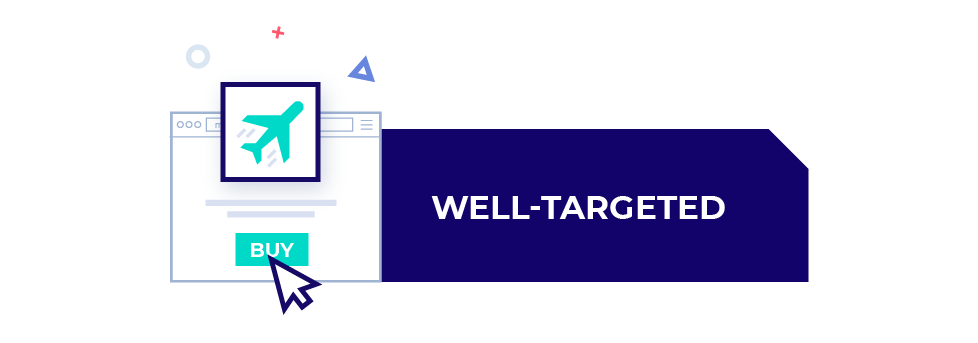
First, make up your mind if you want to run a broad or source-based campaign. The first option, also known as RON (Run-of-network) allows you to buy all traffic from a specific location up to a bid limit you set. The second one allows you to focus on already chosen sources, thus would be recommended only after the initial testing phase is completed.
Once again, a good quality traffic source should be able to provide you with several targeting options. Especially important for push traffic would be the following settings:
- City and region targeting: you can go big, or you can go small, it’s up to you. Whether you decide on the first one and run broad geo (country location-based push advertising) campaign or decide to get more granular (city location-based push advertising) try to make sure you know your audience well enough. This may seem odd but even the most obvious information counts — put yourself in your target audience position, and you’ll be able to predict some of the user behavior right at the start. Also, the average bid prices are heavily dependant on a particular geo location’s performance, thus it’s also an important thing to bear in mind.
ANTI-FATIGUE TIP: Try getting more precise with where your ads are promoted, instead of running one broad campaign. With just one set of ads, you risk your campaign burning out much sooner than if you keep rotating your ad sets among various target locations. Thanks to that trick users are not exposed to the same ads but instead receive more diverse sets more frequently.
- Desktop or mobile device targeting: as the name says, these allow you to choose your target audience depending on the device you’d like to display your ads. Of course, choosing both is usually possible as well.
ANTI-FATIGUE TIP: Which one’s better is a hot topic right now. Mostly, mobile push ads are the place where all the people are at. But it also means this is where the biggest competition is, too. Since push ads, notifications are website notifications, and not app notifications, desktop is a perfectly suited push ad environment, too. Think what’s your campaign goal, test it, and then decide but don’t cross any of the options before you try them out.
- Dayparting and frequency filtering: allow you to decide exactly when and how often your ads will be displayed to a user. Try researching the peak performance for the given location and device type and you can save yourself a lot of time and energy by skipping low-performing traffic.
ANTI-FATIGUE TIP: this is the targeting option for push ads notifications when fighting creative fatigue or ad burnout. Keep your ads at a reasonable frequency level and don’t be too pushy. Remember how non-intrusiveness is what makes push ads so user-friendly and encourages them to voluntarily subscribe to receive website notifications.
The above targeting options can get even more detailed depending on what a traffic source platform can offer you. Remember they’re there for a reason so make the most of them to test and later boost your push traffic campaign performance.
Testing and optimizing your push ad traffic campaigns
If we launch our push ads campaign and have all its events tracked carefully, we’re able to identify what’s working and what’s not already after a couple of days. Before we go into optimization we need to analyze the testing phase’s first findings. That’s when trackers come into the game and testing our campaign setup without actually tracking the campaign isn’t possible.
STEP 1: Look at best-performing geo locations and sources. That’s super easy if you’ve got yourself a good tracker and getting even through vast amounts of data will take you literally seconds to find the best units to run e.g. location-based push advertising. But this applies to every affiliate ad campaign you’ve ever run.
STEP 2: Use ad split testing. With push ads, have a look at the creative performance and eliminate/swap/rotate your creatives if needed. Running A/B tests could work too… but it’d take you way too much time. Some traffic sources allow multiple ad creatives to upload securing even traffic distribution, thus allowing you to identify the best performing items. Select the top performers and create a winning ad set for your push ads campaign.
STEP 3: Get yourself a top-performing source whitelist. Talk to your traffic source representatives, search community forums or look out for any communications coming your way. Why? Because this is how you get lists of top-performing sources to get the traffic from and bid upon. Once you’ve tested your push ads campaigns set up now it’s time to make a profit. Go where there’s money on the table.
Read Hot To Optimize Your Push Ads Campaign Here!
Watch The Zeropark Push Ads Tutorial
For those who’d like to see the theory put into practice, here’s a short push ads video tutorial delivered to you by the Zeropark team. Watch us create a push traffic campaign using the Zeropark platform and see how easy it is if you’ve got the proper tools and resources in place. And while you’re there feel free to subscribe to the Zeropark YouTube channel, you never know you might learn something new!
Why should you go for Push Notification Advertising?
If you’re an affiliate marketer, there are at least several proven benefits of switching to push notification advertising now… and here they are:
✔︎ First of all, push advertising gets you high-quality traffic. As already mentioned, users must subscribe to receive website notifications. It means a real audience, something every affiliate demands from their traffic source.
✔︎ The scale of push notifications advertising is big and its potential is significant. We are talking about hundreds of billions of real users worldwide on a variety of devices (desktop, tablet, mobile). Also, they have already shown interest by subscribing and now they’re there waiting for your offer, crafted especially for their needs! What a treat!
✔︎ Talking about money, keep in mind that push notification ads tend to bring higher Click-Through-Rates than traditional banner ads. This is thanks to users voluntarily opting in for push ads, which leads to more conversions from specific users. Plus, affiliate advertisers pay only for the actual clicks!
✔︎ Remember that push ads get delivered even when subscribed users aren’t browsing the Internet or use their devices at a particular moment. Even though it may take some time for users to take notice of them, push ads are almost impossible to ignore making their visibility way ahead of other ad formats.
✔︎ Although banner blindness, ad fatigue, or market saturation may become an issue with the constantly growing competition, there are ways to break through the barrier and carry on scaling your profits. A good push ad traffic source should be able to provide you with fresh sources and industry insights on how to deal with such problems. If they’re the true know-it-all guys then they’re not afraid of sharing valuable knowledge.
✔︎ Push notification advertising works great during holiday seasons or big events. For example, the e-commerce vertical on push is the hottest trend for the Golden Quarter period. And although the competition is big, advertisers all over the world scale like crazy during this time so don’t miss out on it next time you prepare yourself for Q4!
✔︎ And last but not least – there are no ad blockers in push ads!
Use these seven lucky takeaways to choose the right push advertising strategy!
Run Push Traffic Ad Campaigns
With Zeropark Now!
Kinga Gawron



